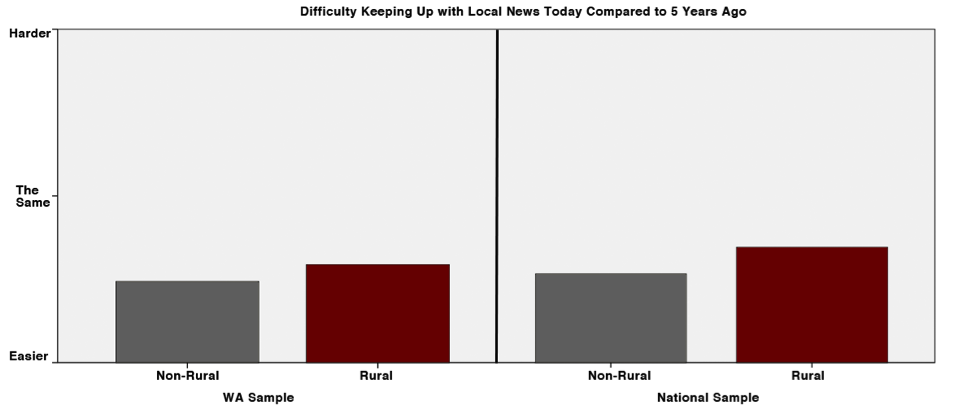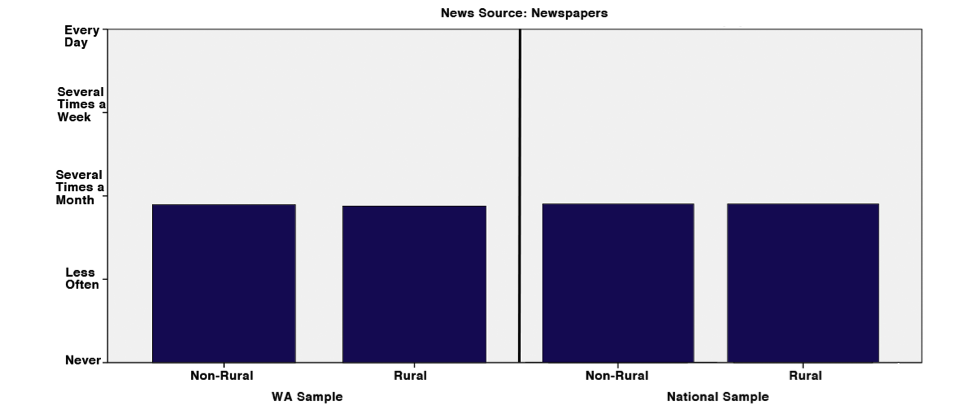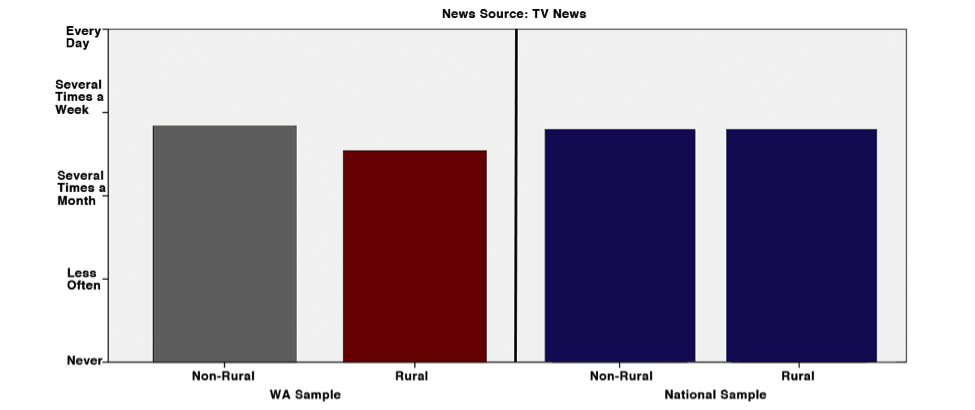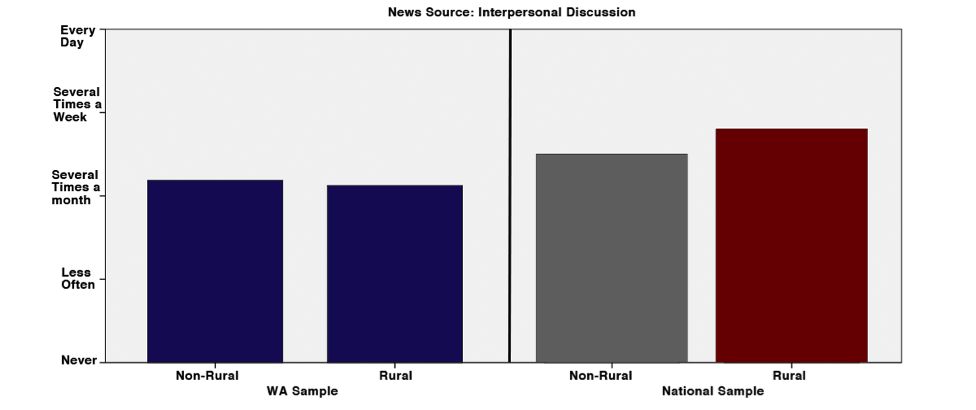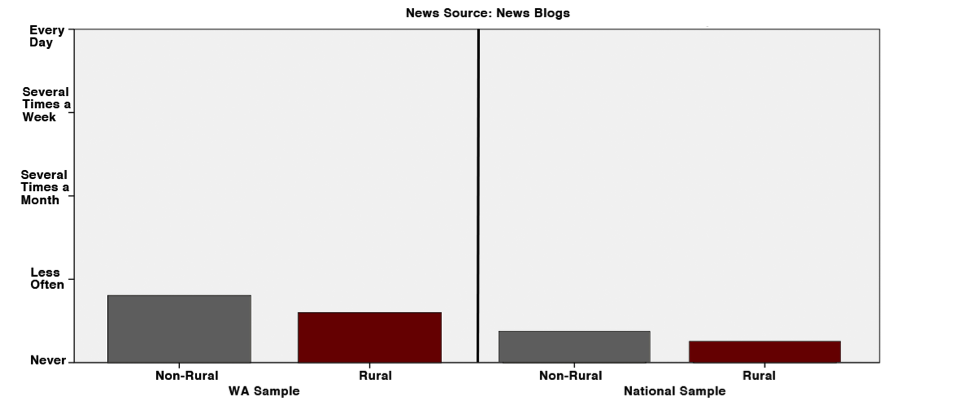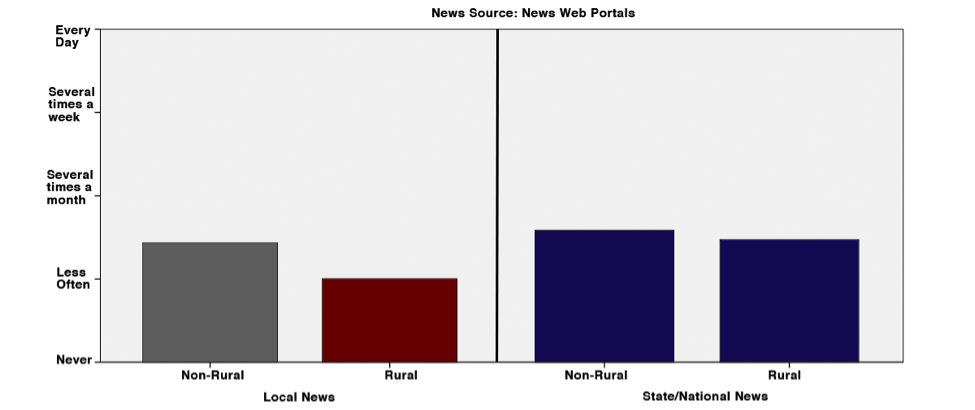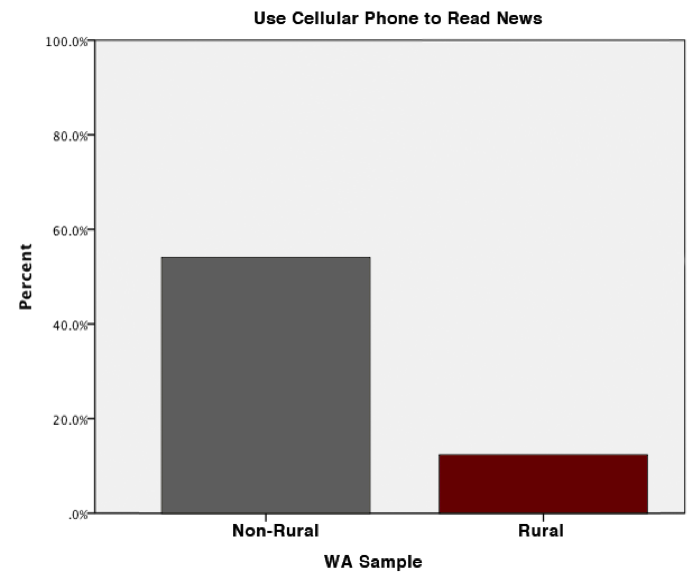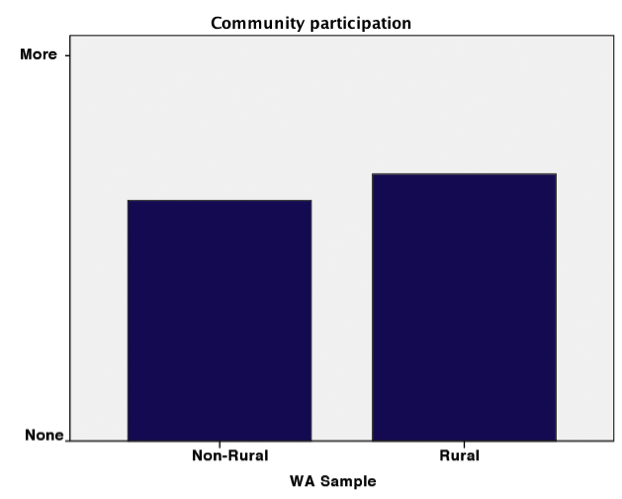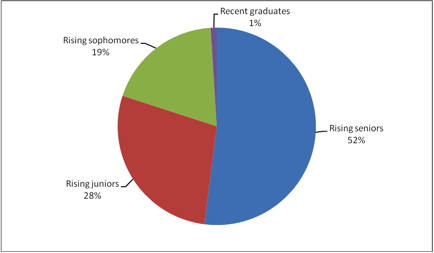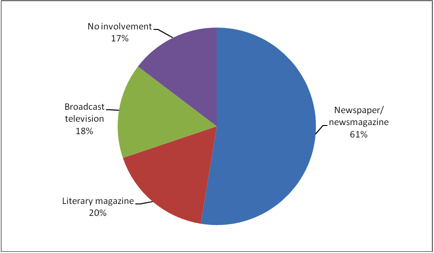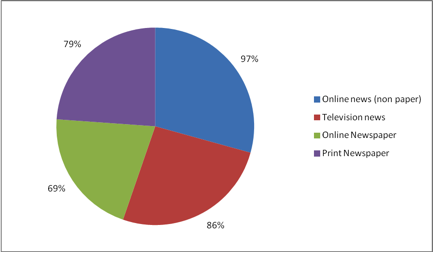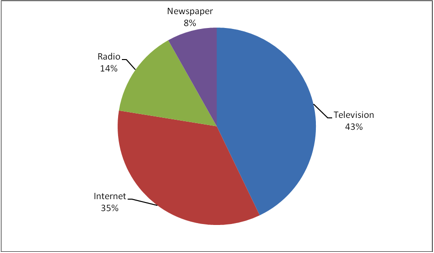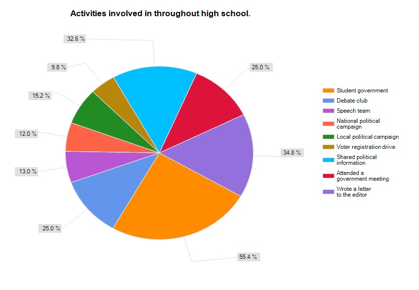Kristy Hess and Lisa Waller
This article provides clarity about the different types of journalism that come under Australia’s vibrant community media umbrella and conceptualizes their relationships to one another against the backdrop of dominant media. We draw on critical-cultural theory, using the concept of media power to argue that journalism invents and reinforces the idea of “community” among audiences, generating advantages and sometimes inequalities as well. It is also used to differentiate certain community journalism practices from mainstream norms and conventions, although we highlight that “community” is a powerful idea that dominant media use to their advantage as well.
“Community journalism” means different things to different people in Australia. It is used to describe a wide range of media that provide information for niche audiences, from radio and television stations run by volunteers, to rotating Twitter accounts set up by activists and newspapers, and online news sites that are owned by global news companies or home office operators. The idea of “community” often conjures notions of collectivity, altruism, shared interests, sense of belonging and collegiality. There is a need, however, to examine the underbelly of this feel-good concept that is often overlooked in broader discussions about community media in Australia. This article contends that “community” is a constructed notion that creates advantages and inequalities and generates boundaries between insiders and outsiders. Furthermore, in this digital world forms of community media are inherently tied to dominant media in one way or another – whether they like it or not.
This article takes up the invitation from American journalism scholar Bill Reader (2012) to draw from the “critical cultural well” in research about community journalism. Reader argues that the cultural studies approach can generate innovative research in this field, even though it challenges many traditions of 20th century professionalism and social science (Reader, 2012). As he points out, the goal of cultural studies is not about “testing hypothesis and finding answers, but rather about discovering new and more interesting questions” (ibid, p.109). Reader outlines some of the broad theoretical frameworks that can be used to understand community journalism from a cultural perspective, including Marxist theory, hegemony theory (Gramsci, 1971) James Carey’s ritual of communication (1989) and Benedict Anderson’s “imagined communities” (1983). This article highlights the benefits of working with an alternative perspective – that of media power (Couldry, 2003, 2012; Couldry & Curran, 2003; Howley, 2010, 2013) – which draws upon some of the well-known paradigms above. This theory helps us to investigate community journalism in two ways: how it is shaped and framed against dominant media; and secondly, the power that comes from a media organization’s ability to construct and reinforce the idea of community related to a geographic region, demographic band, or space of shared interest.
The article begins by providing some clarity about the different types of journalism that come under Australia’s vibrant community media umbrella. It will then provide an overview of the concept of media power, before turning to a discussion of the way issues of power can help to compare and contrast the different forms of community journalism and their relationship to society. We take our cue from scholars who have highlighted the benefits of studying not-for-profit forms of community journalism through a lens of media power, including Howley (2010, 2013) and Couldry (2003, 2012) and advance these discussions to acknowledge that “community” is also a powerful idea adopted by dominant media – the very media that much community journalism serves to challenge.
COMMUNITY MEDIA – AN OVERVIEW
In international scholarship, the idea of community journalism is linked to the local newspaper, especially those serving small towns and cities (see Reader & Hatcher, 2012). But with the rise of new technologies, from radio to television and the internet, the term “community media” has transcended geographic spaces and is now also used interchangeably with alternative, independent, underground and radical media, particularly public broadcasting, blogging and internet sites (Forde, 2011; Ndlela, 2011; Howley, 2010, 2013; Couldry and Dreyer, 2007). There remains some confusion over whether community media is not-for-profit or commercial in nature (see Forde, 2011). Howley (2010), for example, defines community media as an alternative to profit-oriented media that caters for the wide range of tastes and interests of ethnic, racial and cultural minorities, who are often ignored, silenced or otherwise misrepresented by mainstream media:
…This rather generic definition … accommodates a diverse set of initiatives, community radio, participatory video, independent publishing, and online communication to name but a few. (Howley 2010, p. 2)
Forde suggests alternative and community media resonates with the unrepresented, working outside established societal power structures, dedicated to the role of journalism in democracy and occupying a place in the media-scape as “an endangered species” (Forde 2011, p. 53). We have argued elsewhere that community is a weak theoretical framework for understanding commercial newspapers in a digital world (Hess, 2013a; Hess and Waller, 2014). But we also emphasize that community is a powerful idea, rather than a tangible reality, that should be engaged with and understood (Hess & Waller, 2012; Hess, 2014), a point we shall return to soon. Reader and Hatcher (2012) argue that news media today are hybrid models that are hard to categorize using old definitions. They identify a need to study the new ground that exists between the idea of community and journalism that we will extend by drawing upon the Australian experience.
COMMUNITY JOURNALISM IN AUSTRALIA
Australia’s commercial media rests in the hands of relatively few companies and individuals, resulting in one of the highest concentrations of media ownership in the developed world (Finklestein, 2012, p.59). It has been argued that this has led to a narrow range of news and opinion from which people can understand their world and make informed decisions about politics and social issues (Finkelstein, 2012). Community journalism of all stripes is therefore viewed as crucial for enhancing and ensuring Australia’s media diversity (Hess et al., 2014). Community broadcasting in particular, as an alternative medium to public service and commercial media, is argued to foster citizen participation and help to preserve cultural diversity (Forde et al., 2009). It also promotes an overall “Australian-ness” through the creation of Australian content for a heterogonous audience and support for local artists (Jolly, 2014). It is important to outline each of the styles of Australian community journalism before moving on to discuss how a media power perspective can cast some different understandings and questions about how they relate to one another, and mainstream media, in the digital age.
Community newspapers
In international circles, there is much literature that equates the local newspaper with community journalism (see especially Lauterer, 2006; Reader & Hatcher, 2012; van Vuuren, 2007; Bowd, 2007). In this way “community” is often considered synonymous with geographic territory or used in tandem with terms such as country newspapers (Bowd, 2007), rural/regional (Ewart, 2000) or the local press (Buchanan, 2009; Fenton et.al 2010; Franklin 2006). As Lauterer argues (2006), the very idea of community journalism was a choice phrase adopted by American researchers in the 1960s to replace the phrase “hometown newspaper” (see also Byerly, 1961).
In Australia, community newspapers are also understood to serve specific geographic areas. However, there is a need to carefully distinguish between “local” and “community” press in discussions about Australia’s media. It is a practical distinction that also offers an important insight into relationships of power that we will unpack later in this article. Australia’s two big newspaper groups – Murdoch’s News Corporation and Fairfax Media – own many of the nation’s community newspapers. Fairfax’s community media arm is concentrated on the suburban fringes of Australia’s southern cities (Melbourne and Sydney). News Corp Australia’s Community Newspaper Group covers more of the nation, but adopts a similar strategy (News Corp Australia, 2015). These types of community publications are largely understood as free newspapers distributed to households through the letterbox, often weekly, sometimes tri-weekly. They are often free publications that are distinguished from other titles in the company stable that audiences have traditionally paid to read in print, including long-serving local newspapers. In the state of Victoria, for example, Fairfax Media owns and operates the local daily newspaper, The Warrnambool Standard, that serves the vast south-west region. The company’s free community paper Warrnambool Extra, is distributed to households in the immediate geographic region of the city of Warrnambool. The Extra has a higher advertising-to-editorial ratio and provides more social than civic content (events and social photos rather than coverage of local government or the courts). Outside the world of the big mainstream players there are other interpretations of the community newspaper. Van Vuuren (2007) notes that there are commercial community newspapers in Australia that operate independently of Fairfax and News Limited. She defines the community newspaper in Australia as:
Those that are distributed monthly, fortnightly or weekly to residents of particular suburbs or localities, either delivered directly to households or available from local traders or on the pavement at shopping centers, and often free of charge. (van Vuuren, 2007, p.8)
Van Vuuren cites a 2005 News Corporation study of 6,500 people that found two-thirds of Australians considered their community newspapers to be the medium of most relevance to them (ibid, p.96). The Community Newspapers of Australia (2015) association, meanwhile, uses phrases such as “suburban” and “local newspaper” as synonymous with community media and under this definition they are distributed for free in print and online spaces. At the state level, the Community Newspaper Association of Victoria (2015) defines a community newspaper as “a newspaper or newsletter that is owned by the community”. This could mean a newsletter produced by a community house, or a newspaper put together by a group of volunteers for a town or community group. This implies that such media are created as not-for-profit products that serve horizontal networks, separated from the powerful and the elite.
Community broadcasting
Australia was one of the first countries in the world to introduce not-for-profit community broadcasting (see Forde et al., 2009) and community radio is arguably most closely associated with the community journalism tag. It is often referred to as being a not-for-profit radio station, run primarily by volunteers, drawn from the community that the radio station is targeting as its audience. Community stations broadcast in remote and rural places, as well as suburban and urban areas. Community broadcasting has been described as playing an important role in Australian culture by:
… empowering participants, providing voices for different cultures and minorities, delivering local news, information and views, providing alternative music formats, a forum for Australian musicians and writers and programs that create a sense of belonging for people and maintaining projects which nourish Australian content in the face of an increasing reliance on overseas content by other broadcasters. (Jolly, 2014, “concluding arguments”)
The Australian community broadcast sector has 360 community radio licensees, 66 per cent of which are located in rural/regional Australia (Community Broadcasting Foundation, 2015). Australian Community Broadcasting distinguishes itself from other media by actively promoting access and participation in the processes of media operations, administration and production. It is volunteer-driven, with more than 20,000 volunteer broadcasters and support staff helping to deliver media “for the people by the people” (Community Broadcasting Foundation, 2015, para 3) The McNair Ingenuity research study ,of community radio found that 64 per cent of non-metropolitan listeners in 2010 and 66 per cent in 2008 nominated local news and information as a reason for listening to community radio (McNair Ingenuity Research, 2008, as cited in Bowd, 2010). However, the 2012 Finkelstein inquiry into Australia’s news media expressed some concern that community radio services related mostly to localized communities, were largely run by volunteers, with little capacity for regular coverage of local news.
One of community broadcasting’s recognized strengths lies in its delivery of radio and television programming for specific cultural and ethnic groups throughout the land (see for eg. Misajon & Khoo, 2008). It is a significant resource for people from non-English speaking backgrounds, as they have few media alternatives, and these broadcasts support language and cultural maintenance. Meadows et al. (2009) found that community radio plays a significant role in the settlement process for migrants and refugees. A Turkish focus group that was part of their study explained how community radio helped to integrate people into Australian life:
It’s very important. Our children are growing up Australians anyway, maybe they’re having difficulty adapting culturally, but through the radio, they will be able to get some help or adapt anyway. And also we see our differences as richness. (Meadows et al., 2009)
Community broadcasting also helps people who have been in Australia for some time to keep in touch with their cultural heritage. Many community radio stations deliver programs of interest to a number of groups. For example, Jolly (2014) notes that in Australia’s national capital Canberra, community radio station 2XXX broadcasts programs made by and for the city’s Korean, Finnish, Chinese, Greek and Spanish communities.
There are debates as to whether community stations should stress localness and service the local “geographic” population, or emphasize participation and provide a platform for under-represented voices, views and cultural products (Gordon, 2009, p.62). It can be argued that while these tensions and debates exist, community broadcasting in Australia is engaged with the issues and strives to provide a wide range of services and cater to diverse audience needs (Jolly 2014).
Alternative media
Radical, or alternative journalism is found increasingly in online and social media spaces, but there is a long tradition of print publications, as well as community broadcasting, dedicated to political and social justice causes in Australia (Forde, 1999). Historically, alternative media journalists have been distinguished by belonging to a campaign or movement for which they write or broadcast (Forde, 2011). They have an overriding commitment to their public sphere and always, their public sphere is quite simply that which is not being served, or served properly, by the mainstream news media. Forde (2011) suggests such media is more closely aligned than any other form of journalism with the unrepresented, the “poor and downtrodden” (Downing, 2003 quoted in Forde, 2011).
Indigenous Australians are among the most disadvantaged on measures including health, education, home ownership and incarceration (Australian Productivity Commission, 2011), but they have succeeded in creating what is arguably one of the largest, strongest and most distinctive alternative media subcultures in Australia. It is mature, prolific, uncertain and evolving. Waller et al., (2015) describe it as “the consummate expression and achievement of the politics of voice, or speaking up, in the Australian media landscape”. Indigenous media is dynamic, at times working to redefine its use and meaning (Michaels 1986; Rennie & Featherstone, 2008). Diversity and differences of purpose, as well as uncertainty, are part of its essence, offering space for difference of opinion and delivery. The histories and aims of a wide range of Indigenous media outlets confirms the pivotal role they play in Indigenous activism and as mechanisms for debate and development of public opinion which has long been recognized (Hartley & McKee, 1996, 2000; Hartley, 2003; Forde et al., 2009). Indigenous media operates across all platforms, with newspapers that advocate for Indigenous rights including Land Rights News, The Indigenous Times and Koori News. There is an extensive national network of Indigenous community radio, as well as three community television networks (see Waller et al., 2015 for a full discussion). Indigenous journalists campaign for social justice in online publications such as The Koori History Website and social media, with Twitter proving an especially popular and successful platform for radical Indigenous journalism.
UNDERSTANDING MEDIA POWER
We have sketched what we consider to be the spectrum of Australia’s community media sector, highlighting that while they all share the descriptor of “community” they can differ quite dramatically in their motivations and approaches to news. To unpack this further we return to cultural theories of media power that challenge the political economy view of ownership and control by major media players (McChesney, 2003). The cultural approach is also critical of the normative, Fourth Estate view of journalism’s power coming from its role as democracy’s watchdog (Zelizer, 2012). It emphasizes the media’s own power to construct reality, or frame the way we see the world (see Couldry, 2012). In the words of Maras (2013), media power means more than:
Just the power of the press and includes the capacity of media to “do” certain things, its power within (and over) society and power struggles between different parts of the industry and profession. Media power describes how the press and journalism occupies its field and has to do with the way public discourse is imagined and promoted and controlled, via terms such as “objectivity”. (Maras, 2013, p.12)
The concept of media power has not figured strongly in studies of community newspapers (see Hess & Waller, 2014), but it has proved a robust theoretical paradigm for understanding the social significance of not-for-profit journalism that provides media access and advocates for social equity (see especially Couldry & Dreher, 2007; Howley 2010). For example, Howley (2010) says:
For those with little or no access to mainstream media, community media provide resources and opportunities for marginalized groups to tell their own stories in their own voices. They are instrumental in protecting and defending cultural identity while simultaneously challenging inaccurate, prejudicial media representations. (Howley 2010, p.5)
In the discussion that follows here we will highlight how the ability of media organizations to construct and reinforce the idea of community among audiences can generate power and inequality on all levels. We will also demonstrate how media power helps to differentiate and contextualize Australia’s community media sector in terms of its relationship to dominant media and society.
Repositioning “community” through a media power lens
Couldry (2003) draws on Bourdieu to suggest media power can best be understood as the media’s symbolic power of constructing reality (Bourdieu, 1991, p. 166). In Introduction to Reflexive Sociology(Bourdieu & Wacquant 1992), Bourdieu used the term “meta-capital” to describe the concentration of different types of capital in the state, giving it power to decide what counts as capital in specific fields. Couldry argued that the media’s power could be theorized the same way:
Just as the state’s influence on cultural capital and prestige … is not confined to specific fields but radiates outward into social space generally, so the media’s meta-capital may affect social space through the general circulation of media representations. (Couldry, 2003, p. 688)
Much like Anderson’s (1983) idea of the imagined community, viewing community journalism through a lens of media power helps to untangle the assumption that community is in some way a tangible reality. As Webb et al. (2002, p. 88) observe, one of the enduring beliefs in most societies is that “community” in both local and national contexts has a real existence: “An identity as tangible as the continents and as natural as the Amazon forest or the Rhine river”. They argue that community is not natural or inevitable. It is constructed by a series of discourses about society. Shaun Moores (2000) follows Anderson to argue that community might be best understood as a “fictional reality” – communities appear to have an objective existence but are actually products of the imagination (Moores, 2000, p.39). Elsewhere we, among others, have argued that media organizations, especially small newspapers, are considered to be in a powerful position to construct community ideas and values (see eg Hess & Waller, 2014; Hess, 2014; Reader & Hatcher, 2011; Howley, 2010; Mersey, 2010; Ewart 2000). For example, Mersey (2010) contends that within boundaries of community, feelings of emotional safety, a sense of acceptance and willingness to make a personal investment can develop (Mersey, 2010, p.63). We must provide scope therefore to examine how dominant media might maintain economic and symbolic power by constructing and reinforcing the community ideal.
Hess (2014) draws on cultural studies to rethink the theory of social capital in regards to commercial local newspapers, both those that are independently owned or belong to a major media company. These are the types of publications that are also considered to be synonymous with notions of ‘community’. She argues the concept of “mediated social capital” places commercial local newspapers in a position of advantage within the geo-social spaces they serve because they are seen as central to social order. They generate feelings of unity and drive a sense of collectivity among audiences, especially in times of crisis like natural disasters (Hess, 2014). This places such media outlets in a position of advantage – it may generate economic capital in terms of advertising, be used for reputation building, social networking or lobbying – what Hess conceptualizes as mediated bonding, bridging and linking social capital (see Hess, 2014).
The same idea may also apply to alternative community media. Bourdieu (1986) argues that in any social network there is a degree of symbolic power bestowed on leaders to speak on the group’s behalf. Take the alternative, Indigenous journalism example of @IndigenousX, which was founded by activist Luke Pearson. @IndigenousX is a rotating Twitter account that features a different Indigenous commentator on a new topic each week. Evidence of the symbolic capital generated by @IndigenousX can be found in the fact that The Guardian’s Australian online site now promotes and provides a platform for the featured @IndigenousX columnist every week. It is an example of user-driven innovation and of how Indigenous voices are emerging strongly in the rapidly evolving digital landscape. Sweet et al. (2013) argue its effectiveness now ranges from it providing the means to “both scale and tear down barriers to participation” (2013, p. 108); to fostering cultural emotional and social wellbeing; as a journalistic innovation and a community development intervention.
The dark side of community
The media’s power to construct community can also be used to create difference and inequality. Recent Australian research shows how this can at times create “polarizing” views (Ewart, 2014, p.804). Hess (2013, 2014) highlights how the news media’s ability to generate a sense of community can restrict outsiders and has a dark side. She provides examples where minority groups are under-represented in Australia’s country newspapers and discusses how this can contribute to social exclusion. We must be careful to acknowledge that generating feelings of unity and sense of collectivity among audiences, especially in times of crisis such as terrorist attacks, can result in exclusion as well as inclusion. In a complex, globalized world, a retreat into “communities” can be a refusal to engage or connect with difference and complexity. Deuze (2007) argues contemporary society is anything but solid or socially cohesive. He says under conditions of worldwide migration (of capital and labor, global conflict and environmental apprehension) most people experience a growing precariousness in everyday life. “As a response, citizens increasingly retreat into hyperlocal enclaves (suburban ghettos or guarded-gate communities) or global personal spaces such as Facebook” (Deuze, 2007, p. 671). People involved in all forms of community journalism are constantly negotiating what it means to be part of the community – not only bringing community into existence, but also questioning and contesting how it happens and the shapes it takes (see Hess & Waller, 2014). We must also acknowledge that in the process there is a risk that certain voices will not be included, or heard (Dreher, 2010).
Rethinking relations with the mainstream
A clear characteristic of all forms of community journalism in Australia is that they provide a crucial service by promoting and/or giving value to news and information that is not covered by mainstream media. ElGhul-Bebawi (2010) argues there is a blurring between mainstream and alterative media, but that ultimately the distinguishing feature will be the way community media contest mainstream media power (see also Couldry & Curran, 2003; Couldry & Dreher, 2007). One way of understanding this relationship more generally is through an examination of how forms of community media fill gaps in mainstream news media presence and coverage of localities, events and people. However, taking a media power perspective means we must also explore how community media relates to dominant media channels in this changing digital world.
Communities that the big players don’t speak to or for
Australia is a diverse, multicultural nation where the English language dominates the media and mainstream coverage of news from other countries does not always satisfy the needs of people with close links and interests in those places. This gap is filled by Australia’s vibrant ethnic media scene, celebrated for its contribution to cultural diversity and cultural maintenance (Cover, 2012; 2013). There is not space here to explore the sector in depth, but there is a well-established ethnic press that has extended online, as well as a strong accent on ethnic programming on community radio and television that delivers local, national and international news, information and entertainment. In the state of New South Wales alone, there are dozens of publications in some 30 different languages, from Arabic to Vietnamese. Radio 2000 in the capital, Sydney, is a full-time multi-lingual community-based radio station and there are at least 10 community radio stations that broadcast part-time in community languages (NSW Government, 2015). On the other side of the nation, Western Australia has 18 ethnic print media outlets and at least 11 community-based ethnic radio stations (Government of Western Australia, 2015).
Other groups, including senior citizens, gays and lesbians and people living with disabilities are often critical of mainstream media in Australia for the negative ways in which they are represented, or are made invisible by not being represented (see for example Disability and Media Matters, 2015). In response to this and as a way to build community, they produce their own programs on community radio and television, and also in niche print and online publications that provide news and information that connects those involved with their communities (van Vuuren, 2007). An example is an online publication called The Senior (2015) that provides news, information and targeted advertising for older Australians.
Demanding the big players’ attention
A key aim of alternative media groups and journalists in Australia is to have an impact on politics and policies across a range of issues – from the environment, to social justice, trade agreements and international relations – by influencing public debate and agitating for change. The literature on mainstream journalists’ sourcing practices shows that they listen most closely to their elite sources and their reports reflect the agendas of these powerful actors (Soley, 1992; Koch-Baumgarten & Voltmer, 2010). The “gaps” alternative media try to fill include the mainstream’s lack of attention to certain issues and/or where news angles reflect powerful news sources’ views at the expense of ordinary or marginalized members of communities, who are sometimes portrayed negatively. Participants in what are termed “news interventions” (Howley, 2013) therefore target mainstream news in order to influence news agendas and representations, which are seen to impact on audiences and interactions between communities. A current Australian example is the Lock the Gate Alliance (2015), which opposes coal seam gas mining. Working with alternative journalists, including Margo Kingston and the New No Fibs citizen journalism project (Kingston, 2013) the alliance and has been highly effective in its use of a range of digital media to communicate with its supporters, the public and for engaging mainstream media interest in the campaign.
Extremely local news and gaps in the media market
It is important to recognize that community journalism in Australia is not entirely independent from the state. For example, community radio relies on government funding to survive (Hallett, 2009). In 2013-14, the Australian Government committed $17.7 million to the Community Broadcasting Foundation to support its activities. Many community newspapers also receive indirect public subsidies through government advertising (Hess et al., 2015). Such government subsidies can be understood as a form of recognition for the social importance of these news services. Free newspapers and community radio that serve small geographic areas are crucial because they provide news and information that is not often available from mainstream news media, including reports about local events and everyday happenings such as road works (Finkelstein, 2012). They exist not to directly challenge media power but to fill the gaps left by the mainstream.
Consider the role of The Meredith and District News in Australia – which is arguably an exemplar of the “community” modus operandi based on altruism, shared interests, collectivity and collegiality. The Meredith and District News (2015) depends entirely on advertising, donations and grants to meet the costs of maintaining the newsletter and its primary motive is to generate a sense of community among readers, not profits. The publication grew from a school newsletter and is now affiliated with the local community center. It unassumingly challenges media power by plugging the gaps ignored by mainstream publications, but also confronts traditional norms and conventions of professional journalism in the way it is produced and presented to audiences. For example, its front page is dominated by a list of contact numbers for civic, community and emergency services rather than news stories, and its content features calls for contributions to a kindergarten cookbook and the announcement of the new school principal.
As Reader and Hatcher (2012) point out, those who study community journalism at this level begin with an appreciation that journalism is not solely the purview of major national and international media outlets:
Community journalism is at the bottom of an iceberg; it forms the greatest bulk of journalism produced in the world, but it goes largely unnoticed by the masses compared to the ubiquitous big media names readily recognized by society at large (The New York Times, the BBC, National Geographic etc.). (Reader & Hatcher, 2012, xiv)
The authors touch on an important point that highlights how dominant media use and abuse the idea of community, depending on the context in which it is considered. Despite the altruistic Gemeinshaft ideals (see Tönnies, 1957) that community represents, from an economic perspective “community” often signifies editorial content that can be used by commercial players to define a niche market in which to sell advertising to highly targeted audiences. A News Corporation study of 6,500 people revealed that 20 per cent of all newspaper revenue in Australia was generated from the “community newspaper” sector (as cited in van Vuuren, 2007). As highlighted earlier, community publications in Australia have often been established by major media companies at low cost (with high advertising to editorial ratios and more social and contributor content). As a result, they have often been distanced from the Fourth Estate ideals and notions of objectivity upheld by larger, long-serving newspapers which boast established reputations. In an interview for a study on how local newspapers connect people with one another, an editor of a daily local newspaper who also oversees a “free” community weekly paper said:
Our free paper is often described as a community newspaper because it doesn’t upset anyone…it covers the fluffy feel-good stuff. (Personal communication with author, March 22, 2012)
This comment resonates with Forde’s idea that community media are the ‘poor and downtrodden’ (2011) – at least within professional journalism circles and illuminates the powerful cultural norms and values at play that determine what is ‘good’ journalism (see Hess & Waller, 2015). Van Vuuren (2007) highlights that little research is undertaken on community publications in Australia as most academics think they “aren’t worth the paper they are written on” (van Vuuren, 2007, p. 96), This is despite research that shows many households value these publications highly and consider them to provide the news and information most relevant to them (ibid).
CONCLUSIONS
We have established that a defining aspect of community media is the way they challenge media power. But in this digital world, it is important to acknowledge that while community media is often celebrated as being independent (Forde, 2011) and serving horizontal ties, such media are connected in one way or another to dominant forms of power – both media and political – whether they like it or not. Future research on community media must provide scope to examine this more carefully in the digital environment. As Curran (2003) contends, “new technology has not fundamentally changed the underlying economic factors that enable large media organizations to maintain their market dominance” (Curran, 2003, p. 227). Community journalism, from alternative blogs to community radio, increasingly relies on hugely profitable global media companies to communicate. While forms of community journalism are seen to push back against dominant media, there is a growing dependence on powerful commercial information channels such as Google and Facebook to reach and engage with audiences, especially in digital space. These are not neutral players in the media world (see eg: Picard, 2014). Viewing this through a media power lens provides a way of seeing that as dominant media changes and evolves, so too does the relationship with community media forms. Media power might become less visible and more fluid as old structures collapse, giving rise to the Digital Dynasty’s new media empires and moguls. Picard (2014) advises that studies about the use of social media should therefore be viewed through a critical lens. He goes further, to argue that all forms of information technology should be studied in terms of power relationships, rather than the naïve perception that the Internet is about widespread democratization (Picard, 2014). Community newspapers and websites that belong to big media corporations are most obviously connected to powerful information nodes and flows through their own networks, as well as via platforms such as Twitter. This means stories deemed important can be picked up more quickly and given traction in other media owned by the same parent company, and further afield.
As Reader (2012) suggests, drawing from the critical-cultural well offers a way of generating innovative research in the field of community journalism. It has helped us to highlight different motivations and approaches to news across Australia’s community media spectrum. It has also provided the framework for understanding media power operates through all forms of community journalism in two ways. First, through their ability to construct “community” in distinctive ways for both public and private good; and secondly, through their relationships with the big, mainstream commercial media channels of the digital age. Community journalism has being widely theorized against the backdrop of dominant mainstream media where it is viewed as filling a perceived news gap, or representing the interests of those who are not given a voice in big media. However, it is important to acknowledge the complexity that rests in its increasing reliance on big commercial media such as Google, Twitter and Facebook to connect with and across audiences in shifting media terrains. This article has also argued that we must provide scope to consider the benefits and inequalities that the power to construct community presents for dominant news media players in this increasingly globalized world.
WORKS CITED
- Anderson, B. (1983). Imagined communities : Reflections on the origin and spread of nationalism. Verso: London.
- Australian Productivity Commission. (2011). Overcoming Indigenous disadvantage: Key indicators. Retrieved from http://apo.org.au/research/overcoming-indigenous-disadvantage-key-indicators-2011.
- Bourdieu, P. (1986). The forms of capital, in J.G. Richardson (ed), Handbook of theory and research for the sociology of education (pp. 241-58). New York: Greenwood Press.
- Bourdieu, P. (1991). Language and symbolic power. Cambridge: Polity.
- Bourdieu, P., & Wacquant, L. (1992). An invitation to reflexive sociology. Chicago: University of Chicago Press.
- Bourdieu, P. (1998). On television. New York: The New Press.
- Bowd, K. (2007). A voice for the community: local newspaper as local campaigner. Australian Journalism Review, 29(2): 77-89.
- Bowd, K. (2010). Local voice, local choice: Australian country newspapers and notions of community. PhD thesis, Adelaide: University of South Australia.
- Buchanan, C. (2009). Sense of place in the daily newspaper. The Journal of Media Geography, 4, 62–82.
- Byerly, K. (1961). Community journalism. Philadelphia: Chilton Company.
- Carey, J. (1989). Communication as culture: Essays on media and society. Boston: Unwin and Hyman.
- Community Broadcasting Foundation (2015). About us. Retrieved from http://www.cbf.com.au/sector/about-australian-community-broadcasting.
- Community Newspapers of Australia (2015). Where we fit in the community. Retrieved from http://www.cna.org.au/
- Community Newspaper Association of Victoria (2015). Welcome to CVAV. Retrieved from http://cnav.org.au/2005/11/welcome-to-cnav/
- Couldry, N. (2003). Media meta-capital: Extending Bourdieu’s field theory. Theory and Society, 32(5/6), 653-677.
- Couldry, N., & Curran, J. (2003). Contesting media power: alternative media in a networked world. Lanham, MA: Rowman & Littlefield.
- Couldry, N., & Dreher, T. (2007). Globalization and the public sphere: Exploring the space of community media in Sydney. Global Media and Communication, 3, 79.
- Couldry, N. (2012). Media, society, world: Social theory and digital media practice. London: Polity.
- Cover, R. (2013). Community print media: Perceiving minority community in multicultural South Australia. Continuum: Journal of Media and Cultural Studies, 27(1), 110-123.
- Cover, R. (2012). Digital Transitions: Minority Ethnic Community Media, Local/Home Hybridity and Digitization of the Means of Communication. Australian Journal of Communication, 39(2), 19-33.
- Disability media matters (2015). Disability voices have to be heard to change attitudes. Retrieved from http://disabilitymediamatters.me.
- Deuze, M. (2007). Journalism in Liquid Modern Times. Journalism Studies, 8(4), 671-679.
- Dreher, T. (2010). Speaking up or being heard? Community media interventions and the politics of listening. Media, Culture & Society, 32(1), 85-103.
- ElGhul-Bebawi, S. (2007). Sustaining the democratic medium: Philanthropy and community radio in Australia. Global Media Journal (Australian edition). Retrieved from http://www.hca.uws.edu.au/gmjau/archive/iss1_2007/saba_elghul.html
- Ewart, J. (2000). Capturing the heart of the region: How regional media define a community. Transformations, 1, 1-13
- Ewart, J. (2014) Local people, local places, local voices and local spaces: How talkback radio in Australia provides hyper-local news through mini-narrative sharing. Journalism: Theory, Practice and Criticism, 15(6), 709-807.
- Finkelstein, R., (2012). Report of the Independent Inquiry Into Media and Media Regulation’, Department of Broadband, Communications and the Digital Economy. Retrieved from http://www.dbcde.gov.au/__data/assets/pdf_file/0006/146994/Report-of-the-Independent-Inquiry-into-the-Media-and-Media-Regulation-web.pdf
- Fenton, N, Metykova, M, Schloseberg, J & Freedman, D. (2010). Meeting the Needs of Local Communities. London: Media Trust.
- Forde, S. (1999). Journalistic practices and newsroom organisations in the Australian independent and alternative press, Australian Journalism Review, 21, 60-79.
- Forde, S., Foxwell, K. & Meadows, M., (2009). Developing dialogues: Indigenous and ethnic community broadcasting in Australia. Bristol: Intellect.
- Forde, S. (2011). Challenging the news: The journalism of alternative and independent media. London: Palgrave Macmillan.
- Franklin, B. 2006. Local journalism and local media: Making the local news. London: Routledge.
- Gordon, J. (2009) Community Radio, funding and ethics: The UK and Australian models, in in J. Gordon (ed), Notions of Community: A collection of community media debates and dilemmas, pp. 59-80. Oxford: Peter Lang.
- Government of Western Australia (2015). Ethnic media contacts Retrieved from http://www.omi.wa.gov.au/omi_ethnicmedia.cfm.
- Gramsci, A. (1971). Selections from the prison notebooks of Antonio Gramsci. New York: International Publishers.
- Hallett, L. (2009) The space Between: Making room for community radio, in J. Gordon (Ed.), Notions of community: A collection of community media debates and dilemmas (pp. 33-58). Oxford: Peter Lang.
- Hartley, J., & McKee, A. (Eds.) (1996). Telling both stories: Indigenous Australia and the media. Perth: Arts Enterprise: Edith Cowan University.
- Hartley, J., & McKee, A. (2000). The Indigenous public sphere: Oxford, OUP.
- Hartley, J. (2003). Their own media in their own language, in C. Lumby & E. Probyn (Eds.), Remote Control: new media, new ethics (pp. 42-66). Cambridge: CUP.
- Hess, K. & Waller, L. (2012). The Snowtown we know and love: Small newspapers and heinous crimes, Rural Society, 2(12), 116-125.
- Hess, K. (2013a). Breaking boundaries: Recasting the small newspaper as geo-social news. Digital Journalism, 1(1), 45-60.
- Hess, K. (2013b). Tertius tactics: Mediated Social capital as a resource of power for traditional news media. Communication Theory, 23(2), 112-130.
- Hess, K. (2014). Mediated social capital and the small-town press. Journalism Studies.
- Hess, K. & Waller, L. (2014). Geo-social journalism: reorienting the study of small commercial newspapers in a digital environment. Journalism Practice 8(2), 121-136.
- Hess, K. & Waller, L. (2015). Hip to be hyper: The subculture of excessively local news. Digital Journalism.
- Hess, K., Waller, L., & Ricketson, M. (2014). Are there news gaps in rural/regional Australia? Researching media plurality beyond Finkelstein. Australian Journalism Review, 36(2), 157-169.
- Howley, K. (2010). Understanding community media. California: Sage.
- Howley, Kevin (Ed.) 2013. Media interventions. New York: Peter Lang.
- Jolly, R. (2014). Media of the people: Broadcasting community media in Australia. Canberra: Parliament of Australia. Retrieved from http://www.aph.gov.au/About_Parliament/Parliamentary_Departments/Parliamentary_Library/pubs/rp/rp1314/Media.
- Kingston, M. (2013). New No fibs citizen journalism project: The CSG social movement. Retrieved from http://nofibs.com.au/2013/10/07/new-fibs-citizen-journalism-project-csg-social-movement/.
- Koch-Baumgarten, S., & Voltmer, K. (2010). Public policy and mass media. London: Routledge.
- Lauterer, J (2006). Community journalism: relentlessly local. Chapel Hill: University of North Carolina Press.
- Lock the Gate Alliance (2015). Join the movement. Retrieved from http://www.lockthegate.org.au
- McChesney, R. (2003). The problem of journalism: A political economic contribution to an explantion of the crisis in contemporary US journalism. Journalism Studies, 4(3), 299-329.
- Maras, S. (2013). Objectivity in journalism. Cambridge: Polity.
- Meadows, M., Forde, S., Ewart, J. & Foxwell, K. (2009). A catalyst for change? Australian community broadcasting audiences fight back. In J. Gordon (ed) Notions of community: an edited collection of community media debates. London: Peter Lang. Retrieved from http://www98.griffith.edu.au/dspace/bitstream/handle/10072/28105/54149_1.pdf. sequence=1
- Mersey, R. D. (2010). Can Journalism be saved? Rediscovering America’s appetite for news. California: ABC-CLIO
- Michaels, E. (1986). The Aboriginal invention of television. Canberra: Australian Institute of Aboriginal and Torres Strait Islander Studies.
- Misajon, R. & Khoo, T. (2008). Pinoy TV: Imagining the Filipino Australian community. Journal of Australian Studies, 32(4), 455-466.
- Moores, S. (2012). Media, place and mobility. New York: Palgrave MacMillan.
- News Corp Australia (2015). Community newspaper group. Retrieved from http://www.newscorpaustralia.com/brand/community-newspaper-group
- New South Wales Government (2015) Multicultural media. Retrieved from http://www.crc.nsw.gov.au/community_engagement/multicultural_media
- Ndlela, N. (2010). Alternative Media and the public sphere in Zimbabwe, in K. Howley (Ed.) Understanding community media (pp. 87-95). Thousand Oaks, CA: Sage.
- Neveu, E., & Benson, R. (2005). Bourdieu and the journalistic field. Cambridge: Polity.
- Picard, R. (2014). The humanization of media? Social media and the reformation of communication, Keynote speech to the Australia & New Zealand Communication Association 2014 conference, Swinburne University, Melbourne, Australia, July 9, 2014. Retrieved from http://www.robertpicard.net/files/Picard_Humanising_of_Media_Speech.pdf.
- Reader, B. (2012). Drawing from the critical cultural well. In B. Reader and J. Hatcher (Eds.) Foundations of community Journalism (pp. 109-123). London: Sage.
- Reader, B. & Hatcher, J. (Eds.) (2012). Foundations of community journalism. London: Sage.
- Rennie, E. & Featherstone, D. (2008). The potential diversity of things we call TV: Indigenous community television, self-determination and NITV. Media International Australia, 129, 52-66.
- Soley, L. (1992). The news shapers: The sources who explain the news. New York: Praeger.
- Sweet, M., Pearson, L., & Dudgeon, P. (2013). @IndigenousX: A case study of community-led innovation in digital media. Media International Australia, 149, 104-111.
- The Koori History Website (2015). The Koori history website. Retrieved from http://www.kooriweb.org/foley/indexb.html.
- The Meredith and District News. (2015). The Meredith and District News. Retrieved from http://www.meredithnews.com.au/images/stories/2014/November%202014%20WEB.pdf
- The Senior (2015). The Senior News. Retrieved from www.thesenior.com.au.
- Tönnies, F., (1957). Community and society (Gemeinschaft and gesellschaft), New York: Harper & Row.
- Van Vuuren, K. (2007). Contours of community: The independent community press in South-East Queensland, 2006. Media International Australia, 124: 96-107.
- Waller, L., Dreher, T. & McCallum, K. (2015, in press) The listening key: Unlocking the democratic potential of Indigenous participatory media. Media International Australia 154.
- Webb, J, Schirato, T & Danaher, G. (2002). Understanding Bourdieu. Crows Nest, New South Wales: Allen and Unwin.
- Zelizer, B. (2012). On the shelf life of democracy in journalism scholarship. Journalism, 14(4), 459-473.
About the Authors
Kristy Hess is a senior lecturer in journalism in the School of Communication and Creative Arts, Deakin University, Australia.
Lisa Waller is a senior lecturer in journalism in the School of Communication and Creative Arts, Deakin University, Australia.
hess-waller